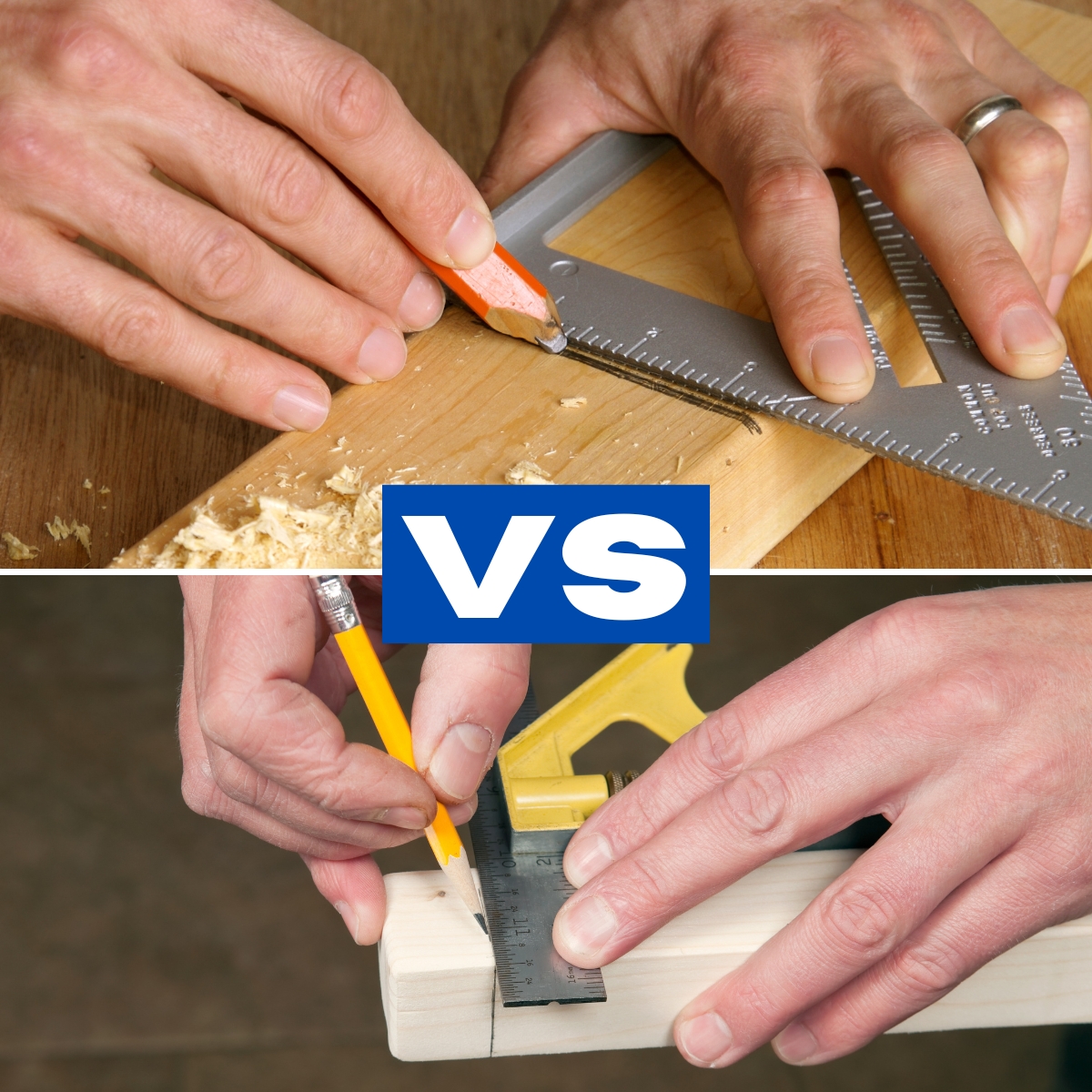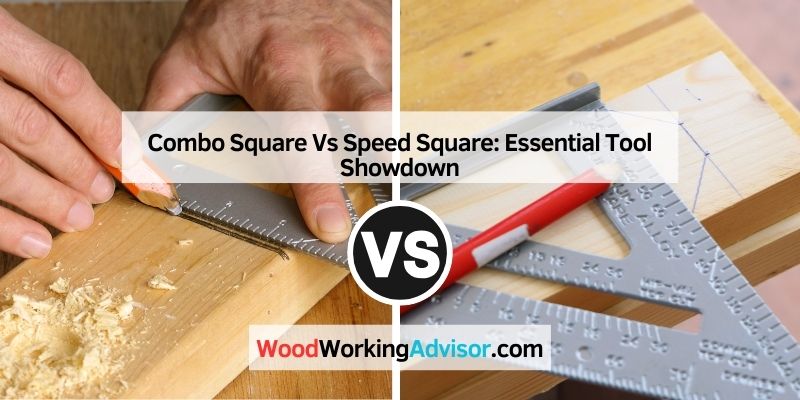Choosing the right tool can make all the difference in your woodworking or construction projects. You’ve probably heard of combo squares and speed squares, but which one suits your needs best?
Imagine the satisfaction of achieving precision and efficiency, knowing you’ve made the perfect choice. These versatile tools can be the key to flawless angles and measurements, and understanding their differences could save you time and frustration. Dive into this comparison to uncover which square will become your go-to tool, enhancing your craftsmanship and boosting your confidence with every cut and line.

Credit: www.thehandymansdaughter.com
Combo Square Basics
The combo square has a rich history. It was invented in the late 19th century. Its design has changed over time. Early versions were simple. Now, they are more complex. Craftsmen used combo squares for precise measurements. Builders relied on them for accuracy. Today, they are still popular. They are used in many fields.
Combo squares have unique features. Adjustable heads are a key feature. They help in measuring angles. Built-in levels are also important. They ensure surfaces are flat. Measuring marks are clear and easy to read. Durable materials make them last long. They often have a scribe for marking. These features make combo squares versatile.
Combo squares have many uses. They are used in woodworking. Carpenters use them to mark lines. They are helpful in metalworking. Engineers use them for precise cuts. DIY enthusiasts use them for home projects. They help in setting angles. Combo squares are also used in construction. They are essential for accurate measurements.

Credit: www.amazon.com
Speed Square Essentials
The speed square has a long history. It first appeared in 1925. A carpenter named Albert Swanson invented it. He wanted a tool that was simple and fast. This tool became popular quickly. Its triangular shape was unique. Today, it is a must-have for many people.
A speed square is a small tool. It usually measures seven inches. It is made of metal or plastic. The tool has a triangle shape. One side has a ruler. Another side is a protractor. It is a great helper for many tasks.
Speed squares are used for many things. They help in drawing straight lines. They are perfect for making angles. Builders and carpenters use them often. It is also used in roofing work. It is a very handy tool.
Material And Design Differences
Combo squares often use steel or aluminum. These materials are durable. Speed squares are usually made from aluminum or plastic. Plastic is lightweight. Aluminum is strong. Each material has its own advantages.
Combo squares have many parts. They include a ruler and level. Speed squares are simpler. They have a triangle shape. This shape helps in making straight lines. Combo squares can measure angles. Speed squares are best for quick measurements.

Credit: www.nytimes.com
Precision And Accuracy
A combo square and a speed square are tools for measuring. Each tool has its own method. The combo square uses a ruler and sliding head. This helps in marking precise angles. It can measure 90 and 45 degrees easily. The speed square is a triangle. It measures angles and cuts wood. It is quick and simple to use. Both tools help in different ways.
The combo square can be more accurate. It has a sliding ruler. This ensures better precision. The speed square is fast but less precise. It is best for quick tasks. For delicate work, choose the combo square. For speed, the speed square works well. Each has its strengths.
Versatility And Functionality
Both Combo Square and Speed Square have unique features. Combo Square offers a sliding ruler. This helps in measuring and drawing lines. Speed Square is simple. It is useful for quick measurements and angles.
Combo Square can measure depth. It is also good for marking. Speed Square is often used for roofing tasks. It has a pivot point for angles. Both tools are handy for carpenters. They serve different needs based on the job.
Combo Square is great for detailed work. It allows for precise markings. Speed Square excels in fast tasks. It is ideal for quick angle checks. Combo Square can measure depths. Speed Square is better for angles.
Both tools help in different ways. Combo Square is good for detailed projects. Speed Square is preferred for quick checks. Carpenters benefit from both. They choose based on the task at hand.
User Preferences And Recommendations
Professionals often choose tools based on their specific needs. A combo square has many uses. It can measure, mark, and level. Many carpenters prefer it for its versatility. Speed squares are great too. They are quick and easy to use. Many builders like them for fast jobs. Each tool has its own strengths. Experts recommend choosing based on your task.
DIY fans love both squares. Combo squares help with precise work. They are handy for different tasks. Speed squares are simple and fast. They are perfect for basic projects. Some DIYers use both tools. They switch depending on their project needs. Many find value in having both options available. It’s all about what works best for you.
Cost And Value Analysis
Combo squares are often priced between $15 and $50. Speed squares are usually cheaper, ranging from $5 to $20. Materials affect the cost. High-quality metal squares cost more than plastic ones. Consider your budget when choosing. Both tools are affordable for most people.
Combo squares offer more functions, adding value over time. Speed squares excel in quick tasks. Both provide good value in different ways. Investing in both can be smart. They last long if cared for. Look for durable materials. A good tool saves money in the long run.
Choosing The Right Tool
Think about what you are building. Combo squares are great for fine details. Speed squares are better for quick cuts. Do you need to mark angles? Combo squares help with that. Are you cutting wood fast? Speed squares are the choice. Each tool has its own job. Pick the right one for your task.
Tools should feel good in your hand. Combo squares are lighter. They fit nicely in small spaces. Speed squares are sturdy and strong. They can be a bit heavier. Choose what feels right to you. Comfort helps you work better. Try both if you can.
Frequently Asked Questions
Is A Combination Square The Same As A Speed Square?
No, a combination square and a speed square are different tools. A combination square has multiple uses, including measuring and marking. A speed square is primarily for quickly marking and measuring angles on lumber. Both are essential for woodworking but serve different functions.
Which Type Of Square Is More Accurate?
Mathematical squares are highly accurate due to defined dimensions and properties. Precision depends on correct measurements and calculations. A physical square’s accuracy relies on manufacturing quality. For best results, use verified tools for creating or measuring squares. Accurate squares are vital in geometry, construction, and design.
What Is A Combo Square Used For?
A combo square is a versatile tool for measuring and marking. It helps check 90 and 45-degree angles. You can use it for depth measurement and as a ruler. It’s essential for woodworking and metalworking tasks. Its adjustability makes it ideal for precision tasks.
What Is The Difference Between Combination Square And Try Square?
A combination square offers adjustable angle measurement, while a try square provides fixed 90-degree angles for checking squareness. The combination square includes a ruler and protractor, making it versatile for various tasks. The try square is simpler, mainly used for carpentry and woodworking.
Both tools ensure precision in construction projects.
Conclusion
Choosing between a combo square and a speed square depends on your needs. Combo squares are versatile. They offer multiple functions in one tool. Speed squares are quick and easy for simple tasks. They excel in basic measurements and angles.
For detailed work, the combo square is ideal. It provides precision and flexibility. Speed squares suit fast-paced jobs. Consider your project requirements carefully. Both tools have their strengths. Pick the one that matches your work style. Remember, having the right tool makes tasks easier.
Happy building and measuring!

